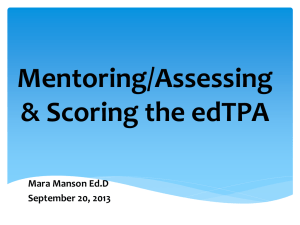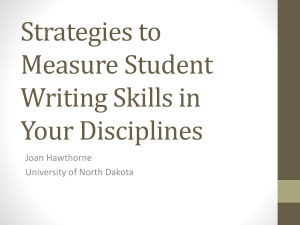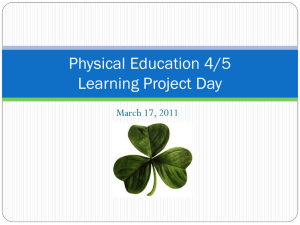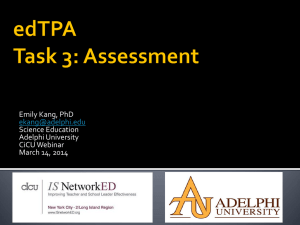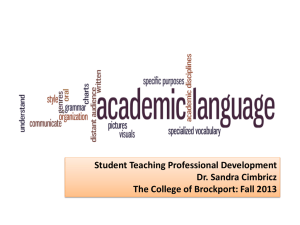Our Vision of CSU as a UTeach institution
advertisement
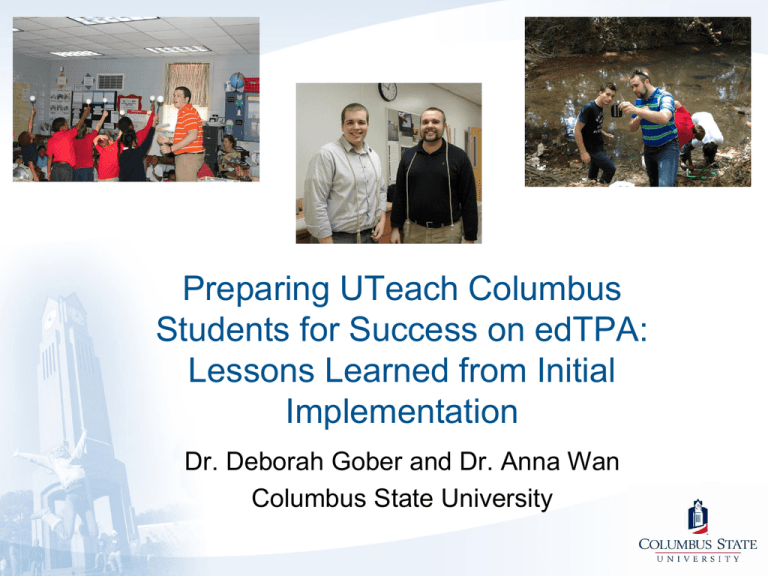
Preparing UTeach Columbus Students for Success on edTPA: Lessons Learned from Initial Implementation Dr. Deborah Gober and Dr. Anna Wan Columbus State University Goals of edTPA “The primary goal is to design, field-test, and offer at scale the first nationally accessible pre-service teacher assessment process designed by educators to:” – Improve student outcomes; – Be used in combination with other measures as a requirement for licensure; and – Guide professional development for teachers across the career continuum. – Help candidates develop the confidence and skills they need to be successful in urban, suburban, and rural schools. Benefits – Provide a uniform and evidence-based process that can be used across states to confirm that aspiring teachers demonstrate their readiness for the classroom. – Measure candidates’ ability to differentiate instruction for diverse learners, including English language learners and special education students. – Create a body of evidence about teacher performance that will ultimately establish a national standard for relevant and rigorous practice that advances student learning. – Allow states, school districts, and teacher preparation programs to share a common framework for defining and measuring teaching performance. The Shift (SCALE/edTPA: http://edtpa.aacte.org/) • Shifting the definition of effective teaching: – From- Successfully delivering the curriculum, “I got through everything I wanted to cover.” – To- Having a positive impact on student learning, “How have I affected student learning?” • Shifting the business of teacher preparation: – From- License as entitlement of completing a curriculum, “But I’ve always wanted to be a teacher.” – To- An obligation to demonstrate the proficiency the curriculum intends, “See, I can teach.” Overview of the Planning Task Artifacts • Instructional and learning context • Lesson plans and Instructional materials, Rubrics 1. Planning to Build Student Understanding 2. Planning to Support Varied Student Learning Needs 3. Using Knowledge of Students to Inform Teaching and Learning student assessment • Planning Commentary 4. Identifying and Supporting Academic Language Demands 5. Planning Assessments to Monitor and Support Student Learning Overview of the Instruction Task Artifacts Rubrics • Video Clips 6. Learning Environment • Instruction Commentary 7. Engaging Students in Learning 8. Deepening Student Learning 9. Subject Specific Pedagogy 10. Analyzing Teaching Effectiveness Overview of the Assessment Task Artifacts • Analysis of whole class assessment • Analysis of learning and feedback to THREE students • Assessment Commentary Rubrics 11. Analysis of Student Learning 12. Using Feedback to Guide Further Learning 13. Student Use of Feedback 14. Analyzing Students’ Language Use 15. Using Assessment to Inform Instruction Rubric progression Expanding repertoire of skills & strategies Deepening of rationale and reflection 1 Not Ready Teacher Focus Whole Class Fragmented, Indiscriminate 5 Proficient Novice Highly Accomplished Beginner Student Focus Individuals/ Flex. Groups Integrated, Intentional & Well Executed Results of External Evaluation (n=19) Spring 2014 Planning Instruction Assessment Rubric 1 Avg Rubric 2 Avg Rubric 3 Avg Rubric 4 Avg Rubric 5 Avg 2.95 2.55 2.55 2.63 2.73 Rubric 6 Avg Rubric 7 Avg Rubric 8 Avg Rubric 9 Avg Rubric 10 Avg 2.89 2.89 2.82 2.79 2.37 Rubric 11 Avg Rubric 12 Avg Rubric 13 Avg Rubric 14 Avg Rubric 15 Avg 2.26 2.55 1.97 2.39 2.29 Results of External Evaluation for UTeach (n=2) Spring 2014 • “3” = proficient (ready to teach) • Both UTeach candidates scored above the average for the college on all rubrics • Areas of strength (at least one candidate rated above proficient): – – – – – Planning for subject-specific understandings Planning to support varied student learning needs Using knowledge of students to inform teaching Planning assessments to monitor student learning Deepening student learning Results of External Evaluation for UTeach (n=2) Spring 2014 • Areas for improvement (Task 3 Assessment) – – – – Analysis of student learning Student use of feedback* Analyzing students’ language use Using assessment to inform instruction *Area with lowest average rating overall and for UTeach Sample Candidate Response • Read the sample teacher candidate response provided and examine the student work. Discuss how you would rate (emerging, proficient, or advanced) this candidate on “Student Use of Feedback.” – Discuss the quality of the feedback given to the three focus students? – How well did the candidate explain how the focus students would use the feedback to improve their work? – Did the candidate discuss how he/she would support student use of feedback to deepen their understanding? Integration of edTPA Classroom Interactions • Lesson Plan Commentary for Teach 1 (edTPA Task 1) • Video analysis for Teach 2 (edTPA Task 2) • Analysis of teaching and student artifacts for Teach 2 (edTPA Task 3) • Peer review of Teach 2 Analysis using edTPA rubrics Integration of edTPA Project-Based Instruction • All tasks – EdTPA aligned template for the lessons taught from the unit – Sketches for remaining lesson plans for the unit – Uploaded for evaluation similar to submission during student teaching • Rubrics – Provided prior to tasks – Peer evaluation using rubrics Next Steps • Design learning experiences that provide opportunities for candidates to get to know the students they are teaching in CI and PBI – Observation Assignment – Getting to Know Your Students – Additional classroom observations? • Create assignments for CI and PBI to give candidates experience in analyzing student learning and giving feedback – Analyzing sample student artifacts as a class and writing feedback; discuss student use of feedback and supports candidates may provide – Analyzing use of academic language A Teacher Candidate’s Perspective • Important takeaways from completing edTPA • Challenges of edTPA • Advice for others completing the assessment Sharing Best Practices

